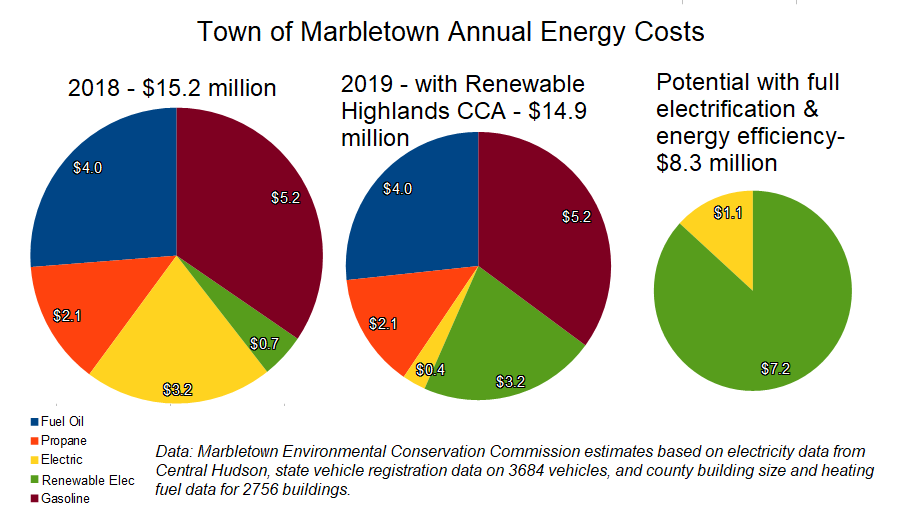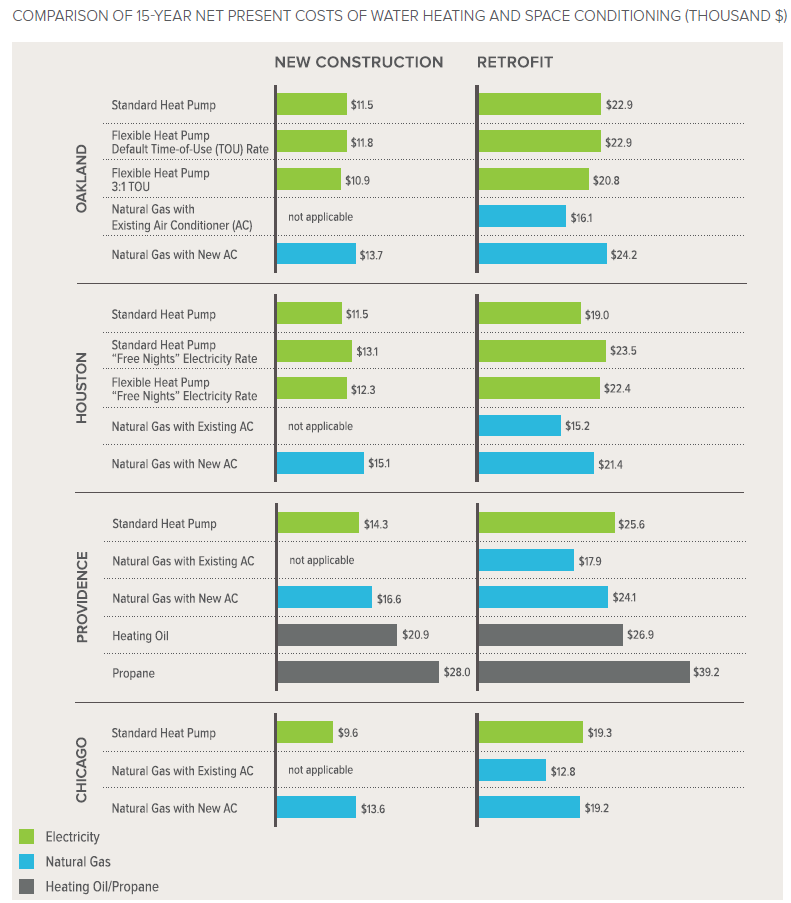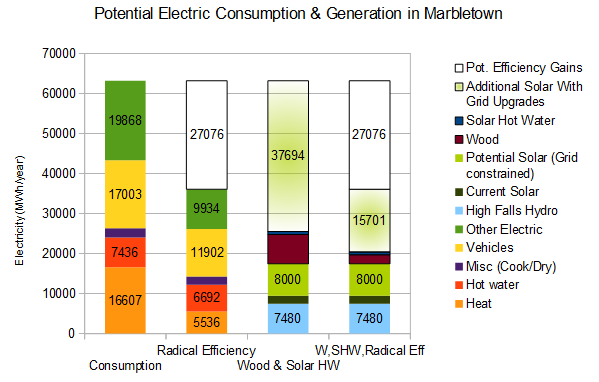A community choice program and a lack of natural gas are enabling Marbletown to achieve 100 percent renewable energy and tackle 100 percent renewable energy —while saving money.
by Tom Konrad, Ph.D., CFA

With advances in technology, the pathways to 100 percent renewable energy are becoming clear. As a result, the central challenge has become less about how to get there, and more about how to pay for it.
The town of Marbletown, in New York’s Hudson River Valley, is finding that problem is solving itself.
Marbletown is a town of 5,500 people covering 55 square miles on the edges of the Catskills and Shawangunk Mountains, containing the hamlets of Stone Ridge and High Falls. The Town’s Environmental Conservation Commission (ECC) and Sustainable Hudson Valley recently conducted a planning effort for 100% clean energy (including not only electricity but buildings and transportation as well.) They discovered that, despite its small population, Marbletown has two advantages that most other municipalities around the country lack: a community-choice aggregation policy and a lack of natural gas.
These two features are enabling this New York town, where this author resides, to achieve 100 percent renewable electricity, while also saving money.

Renewable electricity at reduced cost
Enabled by New York’s Reforming the Energy Vision initiative, Marbletown recently joined the Hudson Valley Community Power, a Community Choice Aggregation (CCA) program. The CCA will take the place of the town’s electric utility, Central Hudson, as the default electricity provider in New York’s deregulated market. The CCA will procure generation for the town. Central Hudson will continue to provide electricity delivery, service and billing. Customers also have the opportunity to opt out of the program at any time, but they will likely have little incentive to do so.
By leveraging the power of group purchasing electricity, the CCA administrator and the town expect that it will be able to provide 100 percent renewable electricity at a reduced price compared to electricity supplied by Central Hudson. If it turns out that the CCA cannot obtain electricity on advantageous terms, the town can leave the CCA at no cost and no further obligation.
When the Marbletown CCA begins operating in early 2019, the vast majority of electricity used by the town’s residents will come from renewable energy resources, while lowering their costs.
Saving money with building electrification
Another thing going for Marbletown — though it may not appear to be the case at first — is its lack of access to natural gas. This lack of natural gas infrastructure enables Marbletown to cost-effectively leapfrog to all-electric buildings, in the same way many countries in Africa were able to leapfrog over the installation of costly telephone infrastructure when wireless phones became available.
Cold climate heat pumps and heat pump water heaters are the cellphones to natural gas’ landlines. The 2018 report The Economics of Electrifying Buildings from the Rocky Mountain Institute (RMI) compared the life-cycle costs of cold climate air source heat pumps (ASHPs) with conventional heating with and without air conditioners in five cities: Oakland, Houston, Providence and Chicago in a number of scenarios.

They found that ASHPs were usually more cost effective than natural gas in new construction, and always more cost-effective than fuel oil or propane heat in the one city where those two fuels are used: Providence, RI.
I spoke to Mike Henchen, a manager with RMI’s electricity practice and one of the authors of the report, to find out how these economics would translate to Marbletown’s climate. He says that the two most important factors in translating the ASHP results from Providence to Marbletown are the somewhat colder climate and the differences in the prices of electricity and fuel oil.
RMI’s modeling found that, because of the colder climate in Chicago, the ASHPs studied are 15 percent less efficient at producing heat from electricity in Chicago than in Providence over the course of a typical winter.
According to the National Weather Service, Providence’s typical winter daily temperature ranges from 24 degrees F to 40 degrees F. For Chicago, that range runs from 15 to 32 degrees, while the typical range in Marbletown is 21 to 36 degrees. Hence, Marbletown’s climate is nearly midway between that of Providence and Chicago for the purpose of winter heating. Hence, we can expect that ASHPs will be around 7 percent less efficient for producing heat in Marbletown than in Providence.
According to the U.S. Energy Information Administration, average retail electricity prices are 16.3 cents per kilowatt-hour in Rhode Island. In Marbletown, electricity currently costs about 13 cents per kilowatt-hour (not including expected savings from the CCA). The EIA number for New York state as a whole is 14.5 cents.
A spot check of heating oil prices in Rhode Island and the Lower Hudson Valley region of New York also finds that Marbletown heating oil prices are approximately 20 percent higher than those in Providence.
With electricity 20 percent cheaper in Marbletown than Providence, and fuel oil approximately 20 percent more expensive, these price differences will completely overwhelm the slight reduction in ASHP efficiency caused by Marbletown’s colder climate.
The cost savings from heating with an ASHP as compared to with fuel oil should be about 30 percent greater per unit of heat than in Providence, due to a combination of lower electricity prices and higher fuel oil costs. Where fuel-oil-to-electric conversions are cost-effective in Providence, in Marbletown they are compelling.
Electric vehicles
Unlike with heating, Marbletown has few advantages in the transition to electric transportation. As a rural town, most residents are completely car-dependent for their everyday needs. One advantage we do have is being located in the center of Ulster County. The county government has been a leader in the installation of EV charging stations at county facilities, and it makes these charging stations available for public use as well.
The town also used a state grant to install an EV charging station at the town’s community center. Marbletown is working with the neighboring town of Rosendale to install an EV charging station at our shared municipal offices, and they are helping two local nonprofits to install EV chargers on their premises.
New York state has a generous grant program for EV charging stations, but the program requires the use of networked commercial stations. In at least two instances, this has made the grants more trouble than they are worth, when the stations turned out to be incompatible with the limited local cell phone network.
Town leaders believe the state grant program could be much improved if it also provided much smaller grants for the installation of non-networked charging stations more suitable to rural areas. The current program is overly focused on high-speed charging along key transportation corridors to the neglect of Level 2 charging at destinations like workplaces and recreation areas, like hiking trails.
Seasonal mismatch
Another difficulty of transitioning to 100 percent renewable energy by converting heating loads to electricity is seasonal mismatch. Heating loads peak in the winter. At Marbletown’s 42° N latitude, the town gets only nine hours of daylight in midwinter, but 15 hours in midsummer. This, combined with a much lower sun angle, leads to solar installations producing only one-half to one-third as much energy in January as in July.
Lower solar production in winter, combined with higher winter electricity demand for heating, will eventually move New York’s peak electricity demand to winter from summer. Solving this problem of seasonal mismatch will be easiest if we start planning today by minimizing winter peak demand and looking for renewable electricity sources that have significant production during the coldest winter months.
Many possible solutions to seasonal mismatch will have to be addressed outside of Marbletown’s borders. The state is pursuing the deployment of 2,400 megawatts of offshore wind, and has significant hydropower resources. More hydropower is imported from Quebec.
Long-distance north-south high-voltage DC transmission projects, such as the proposed Atlantic Wind Connection, would not only enable the connection of large amounts of offshore wind power, but would also allow for the import of renewable electricity to New York in the critical winter heating season. In addition, the lines could export excess solar generation to areas with more significant cooling loads in the summer.
Local resources
Marbletown has no wind resources of interest to wind power developers. Other than solar, its local renewable energy resources are hydropower and biomass.
The town has numerous small streams and an existing run-of-river hydro plant, which it is looking at developing and upgrading with a local developer, Current Hydro. One small stream we are looking at dries up during most summers, but it has such a substantial drop that it forms a beautiful waterfall in the winter. The local property owners cannot see it from their houses, and they worry about trespassers falling and hurting themselves on the ice. Making this attractive nuisance safe by using the water for hydropower would be a great way to both solve a potential liability problem for the landowners, while also producing renewable electricity when it is needed for heating.
Many town residents currently save money by heating with wood stoves, rather than fuel oil. Encouraging the adoption of more efficient wood pellet stoves and advanced wood boilers can also reduce winter electricity use while lowering pollution from less efficient, older models. The state has generous incentives for the installation of advanced wood heating systems.
RMI’s Henchen suggests that the town can also “minimize the winter peak through weatherization.” Focusing on the best heating technologies can also greatly reduce the peak load. The best cold climate ASHPs will use one-third as much electricity over the course of the winter as electric resistance heating, and a little less than half as much on the coldest days, when they are least efficient and heating needs peak. By focusing on replacing resistance heating with more efficient technologies, winter heating loads can be reduced, leaving room for more fuel-oil-to-electric and propane-to-electric conversions.
Incidentally, Central Hudson just launched $750 instant rebates on two models of hybrid heat pump water heaters costing $1,299 without the rebate. The utility’s rebates on smart thermostats can also help shift heating and cooling loads away from peak hours. (The existing rebates on ASHPs are here.)
Next steps
Many policy recommendations for transitioning to 100 percent renewable energy involve utility and incentive programs that are beyond the purview of a rural town of a few thousand people. But we are not entirely without policy levers. The town issues building permits, and has control over building and zoning codes, although changes in building codes require and exemption from the state.
The greatest limitations on what the town can do are the labor and expertise of its small number of employees. This limited capacity is augmented by volunteers on the town’s committees and commissions, the most relevant one in this case being the Environmental Conservation Commission (ECC), which I have led since 2014. The flip side of Marbletown’s small size is that a few volunteers like those on the ECC can have an outsized impact. My team and I have moved Marbletown from the middle of the environmental pack to a town that has drawing positive attention statewide.

Here are some of the steps the town has already taken to move the town towards 100 percent renewable energy.
- Completed an inventory of energy use in the town with Sustainable Hudson Valley (PDF presentation).
- Removal of approximately a third of the town’s streetlights, and the replacement of the remaining lights with LEDs.
- A ban on hydraulic fracking.
- Installation of EV charging stations (noted above).
- Obtaining a $50,000 grant for the energy retrofit of the town’s community center.
- Joined the Hudson Valley Community Power CCA.
- An LED lighting retrofit at the Town Highway Department.
- Participated in a Solarize campaign that resulted in 16 residential solar installations in the town and 30 additional installations in the other two participating towns and beyond.
Current and planned future projects include:
- Connecting several local non-taxable organizations with a solar developer willing to lease their rooftops for community solar developments.
- Working with a small hydropower developer to investigate upgrading the local utility-owned hydropower plant to increase its production, as well as to assess the viability of small hydropower installations where local streams cross town property and right-of-ways.
- A (mostly symbolic) ban on natural-gas connections and pipelines in the town.
- Modifying the cost of building permits to favor building efficiency and electrification, and to favor heat pumps over air conditioners that lack heating capability.
- The adoption of New York’s stretch energy code when it is finalized.
- Working with local solar installers build community solar on municipal property and local nonprofits, such as churches and emergency responders.
- Encouraging local solar installers to include a 240-volt outlet for EV charging as part of solar installations.
Burdens create opportunities
Weaknesses can also be strengths. The high cost of heating with fuel oil and propane has long been a burden on Marbletown residents. Now, it is a strong incentive to switch to a more modern, much more economical, and much cleaner source of heat with cold climate ASHPs. Advances in electric vehicles are enabling similar savings in transportation.
These compelling economics are enhanced by strong support for clean energy by New York state and Ulster County.
All together, these developments are setting the town of Marbletown on a path to a prosperous, clean energy future.









Thanks very much for this analysis. I am on the Environment Committee of my small town of Takoma Park, and we are working towards same goal, and hopefully will have a Community Choice Aggregation plan in place soon. Especially glad to see your insightful analysis of the shift of peak electric needs from summer to winter. Knowing this shift is coming, I was surprised that you didn’t do more analysis on the economics of heating with pellet stoves and pellet boilers. That seems to be obvious choice to pair with heat pumps, or to use instead of them. We have similar issues with NY residential biomass rebates that you note with EV charging. They can be overly restrictive. We need to urge NY to give rebates for pellet stoves to all NY residents, not just ones replacing wood stoves or who are low-income. Thoughts?
Thanks again. GREAT article.
John Ackerly
We are looking in to that… we’ve actually invited one of NYSERDA’s certified biomass boiler installers to our next meeting to bring us up to speed on the technology. Did no know about the issues with the rebates. I agree on your idea for the rebates as long as they are limited to highly efficient, low emission stoves. If you look at this presentation https://www.marbletown.net/sites/marbletownny/files/pages/forging_a_pathway_to_a_100_renewable_energy_future.pdf you will see I addressed it on slides 28-32.
How efficient is it to turn tons of trees into sawdust so it can be processed by an energy-intensive pelletizing process ? Maybe you were considering wood chips instead although there is processing required for these also.
The idea is not to use the whole tree- valuable logs would be used for lumber. The slash and waste from the lumber mill would become fuel. Note the emphasis on “sustainable management” in the presentation I linked to. Nor is the pelletizing process energy intensive. But wood chips are a good idea as well, and I’ve also learned that there are many stoves that can burn cord wood quite efficiently. The most important thing for efficiency is that the wood be very dry. Quality control can be lacking in cordwood; wood pellets are dry when sold and there is no temptation to store them in the rain.
I’m on the Energy Committee here in Plainfield, MA, pop. 650. We got a Green Communities Initiate grant from the State and, because our biggest energy use by the town is diesel for the highway dept. vehicles, our lowest hanging fruit for using grant money is solar arrays on town buildings.
We installed an ASHP in our home a couple years ago and love it. Unfortunately, the local hill town climate makes it less efficient for a greater percentage of the winter. We also just signed on for a community solar membership to get 15% off our electric bill.
As a 45 year biomass heat user, I’d love to see the town utilize the forest waste particularly for some portion of our heating but with all the above factors, I’m afraid it would be a hard sell. Biomass is an under utilized fuel source and doesn’t have the bling factor of solar panels, unfortunately.
The first step for energy efficiency is insulation: walls, windows, doors. After that consider efficient heating and cooling. A mini-split (electric heating and air conditioning unit) is most efficient down to about 25 degrees. I have used hot water solar panels to heat our hot water since Jimmy Carter’s super tax credits, but would not recommend them now. It asks a lot of solar electric to heat your house and your water in winter, so if you live in a colder area I would consider a pellet unit for winter heat and hot water.